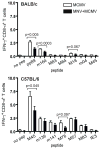Investigation of the impact of the common animal facility contaminant murine norovirus on experimental murine cytomegalovirus infection
- PMID: 19647849
- PMCID: PMC4482231
- DOI: 10.1016/j.virol.2009.05.035
Investigation of the impact of the common animal facility contaminant murine norovirus on experimental murine cytomegalovirus infection
Abstract
Murine norovirus (MNV) is a recently discovered pathogen that has become a common contaminant of specific pathogen-free mouse colonies. MNV-1 induces a robust interferon-beta response and causes histopathology in some mouse strains, suggesting that it may impact other mouse models of infection. Despite many concerns about MNV-1 contamination, there is little information about its impact on immune responses to other infections. This study addresses whether MNV-1 infection has an effect on a model of murine cytomegalovirus (MCMV) infection. Exposure to MNV-1 resulted in a decreased CD8 T cell response to immunodominant MCMV epitopes in both BALB/c and C57BL/6 mice. However, MNV-1 did not impact MCMV titers in either mouse strain, nor did it stimulate reactivation of latent MCMV. These data suggest that while MNV-1 has a mild impact on the immune response to MCMV, it is not likely to affect most experimental outcomes in immunocompetent mice in the MCMV model.
Figures




References
-
- Biggart J, Ruebner B. Lymphoid necrosis in the mouse spleen produced by mouse hepatitis virus (MHV3): an electron-microscopic study. J Med Microbiol. 1970;3:627–632. - PubMed
-
- Brehm M, Pinto A, Daniels K, Schneck J, Welsh R, Selin L. T cell immunodominance and maintenance of memory regulated by unexpectedly cross-reactive pathogens. Nat Immunol. 2002;3:627–634. - PubMed
Publication types
MeSH terms
Grants and funding
LinkOut - more resources
Full Text Sources
Medical
Research Materials

